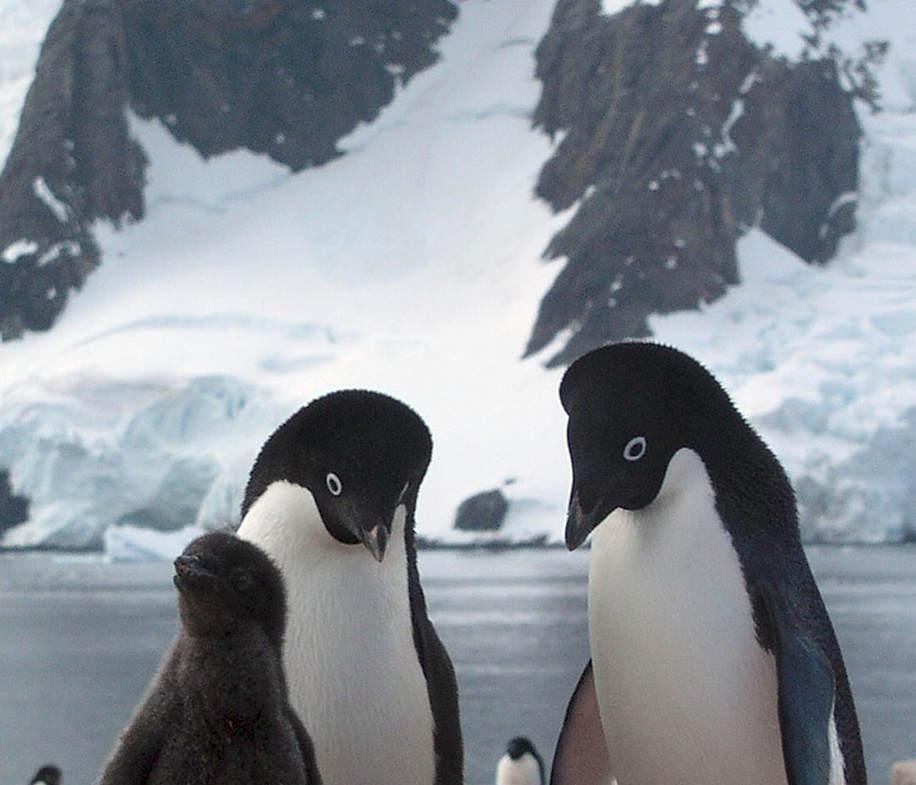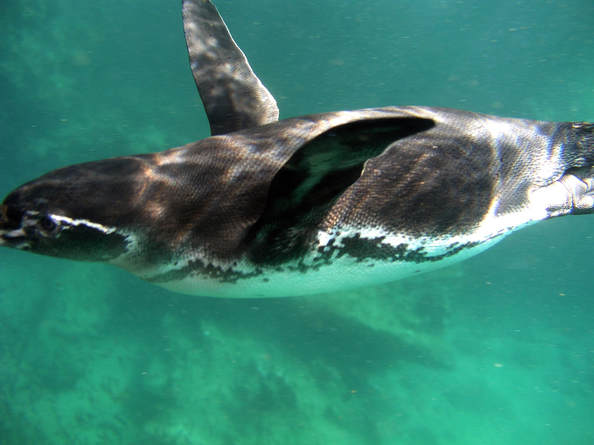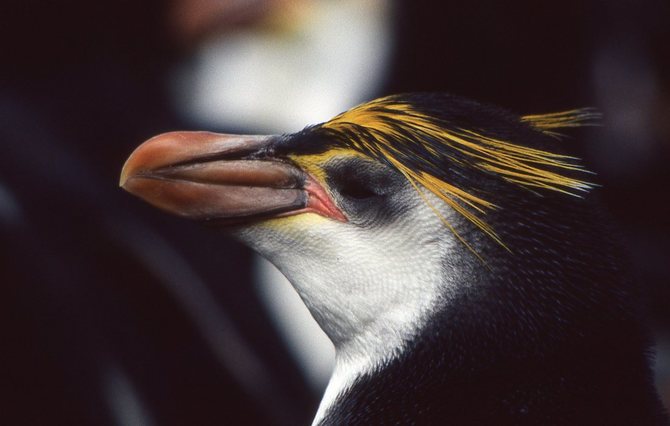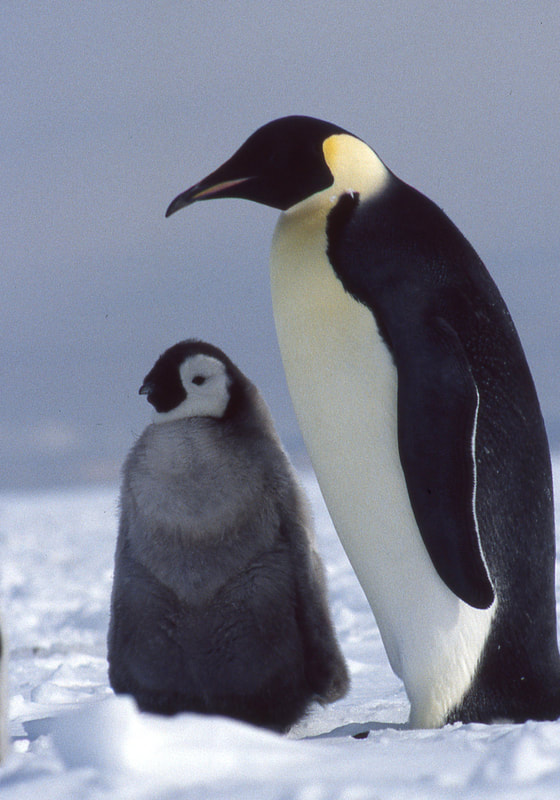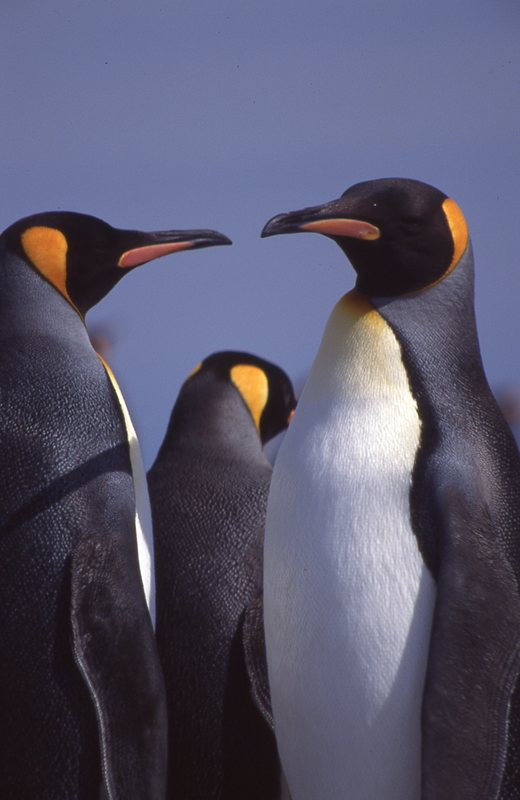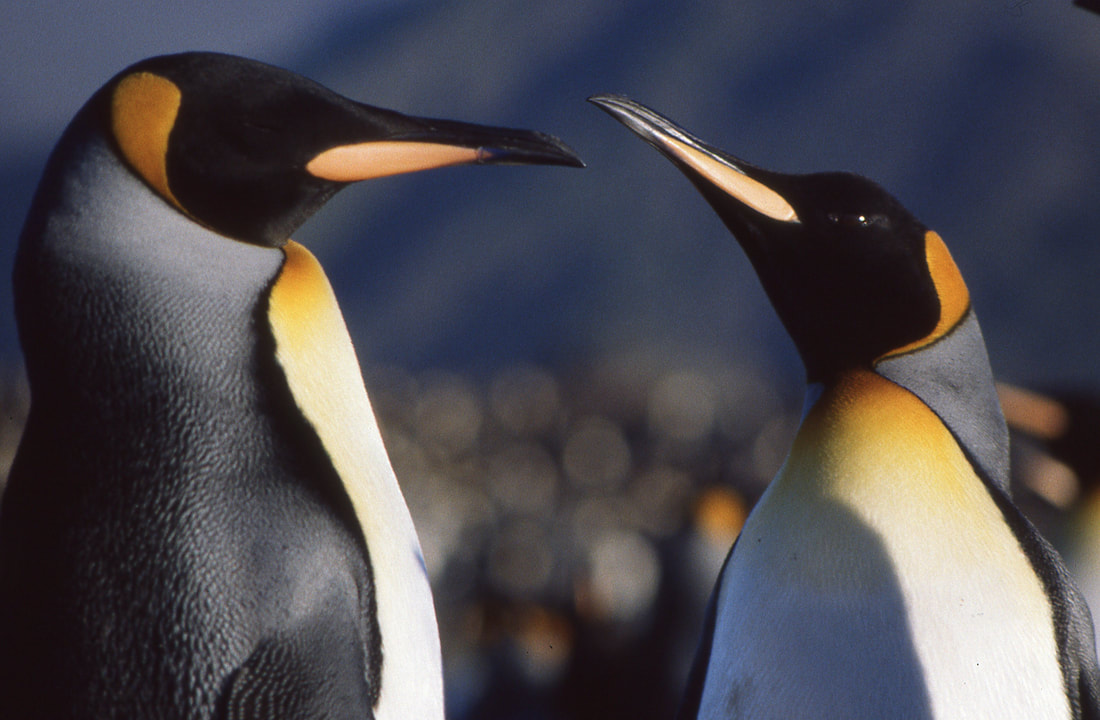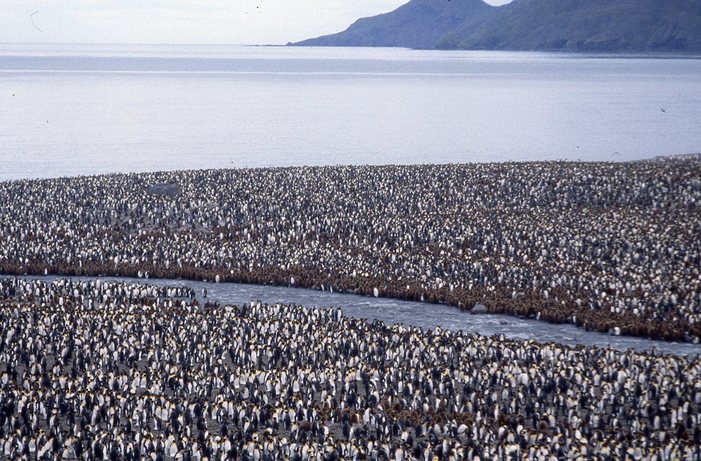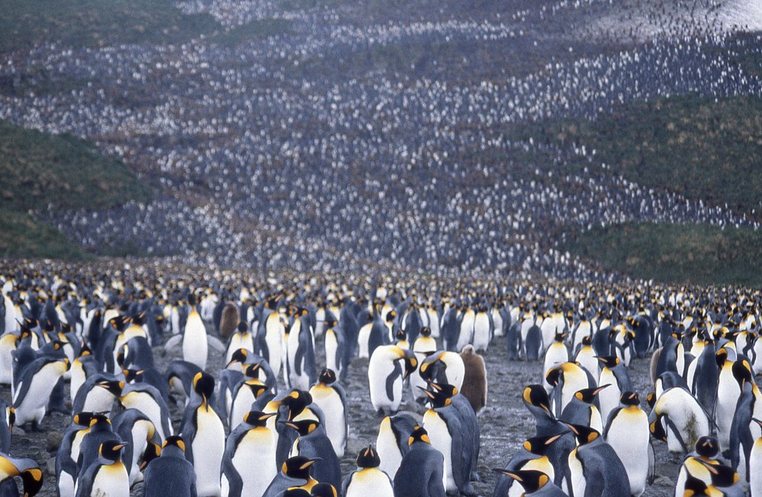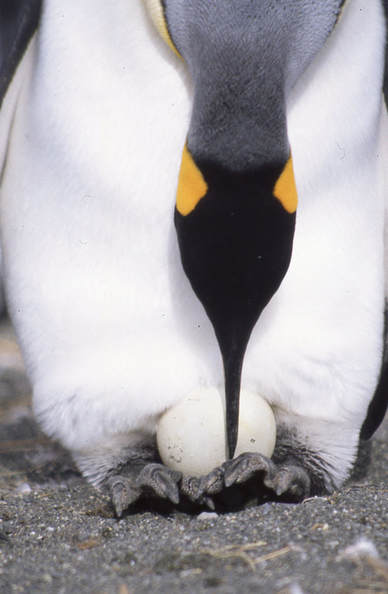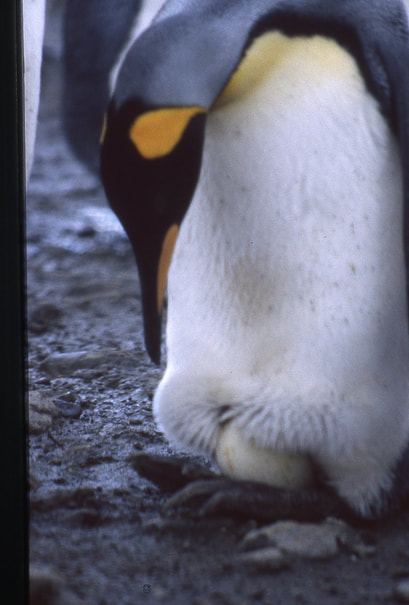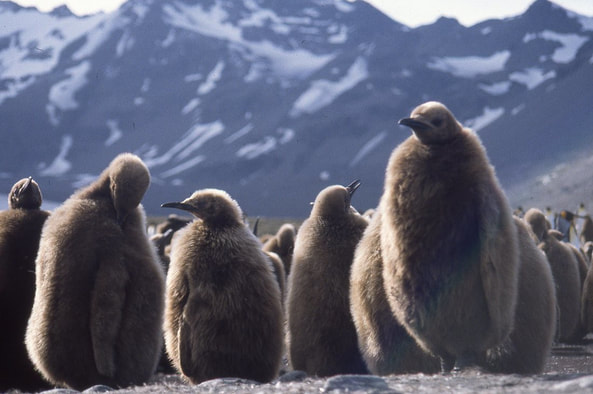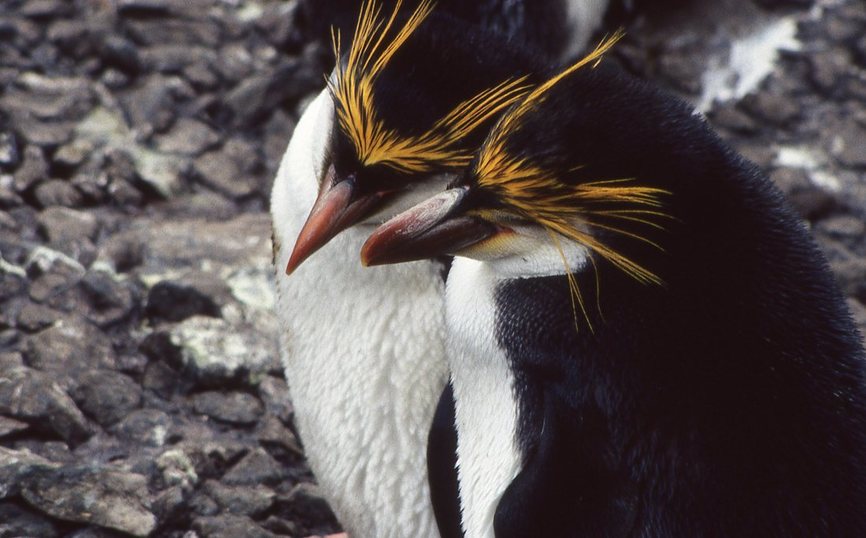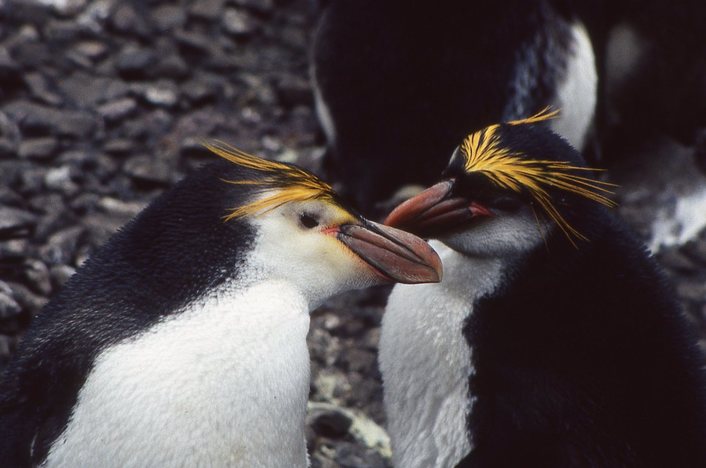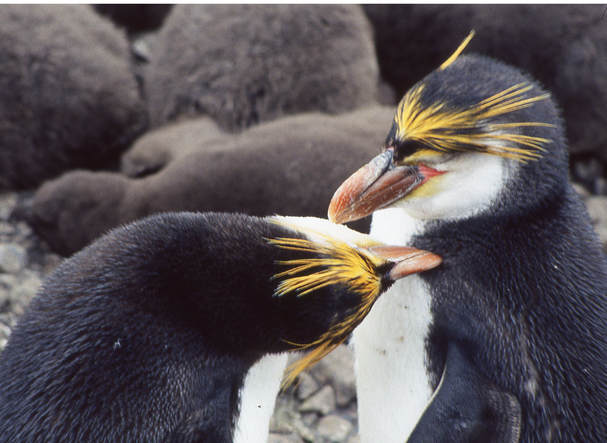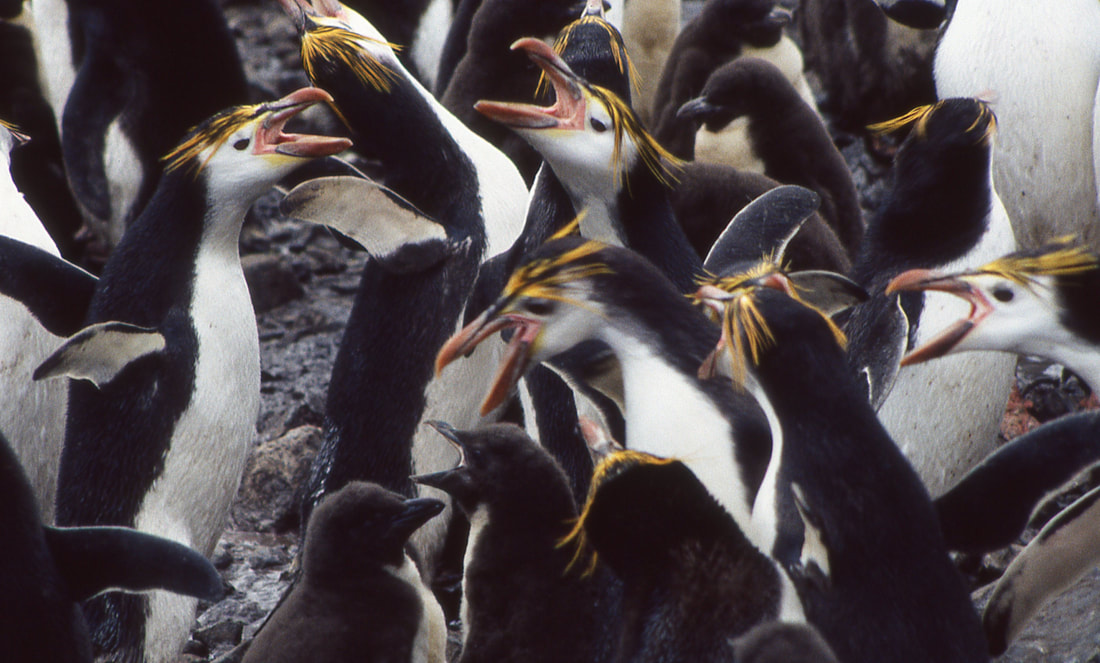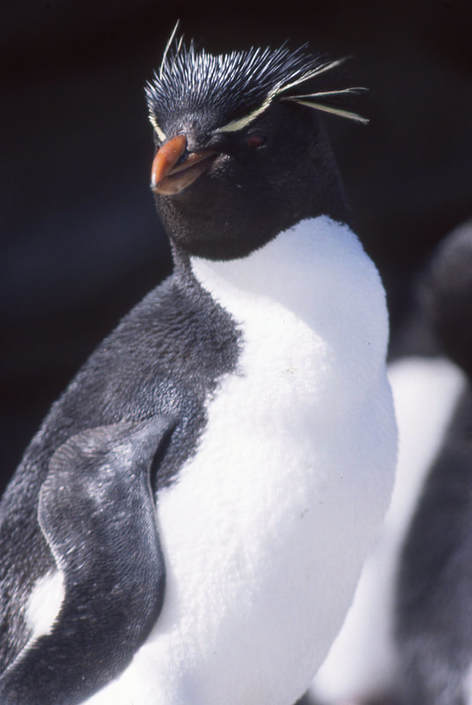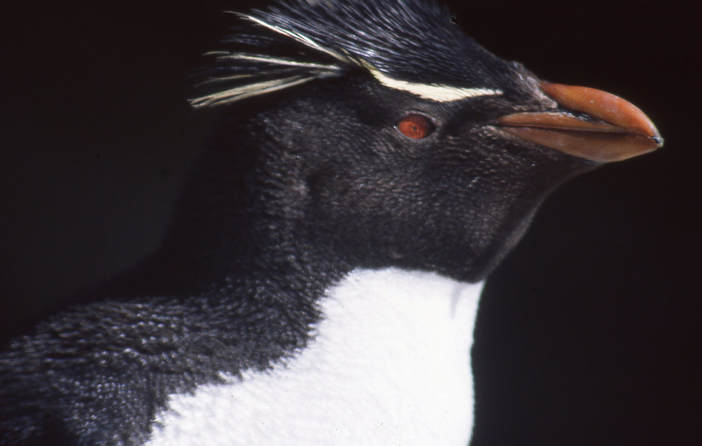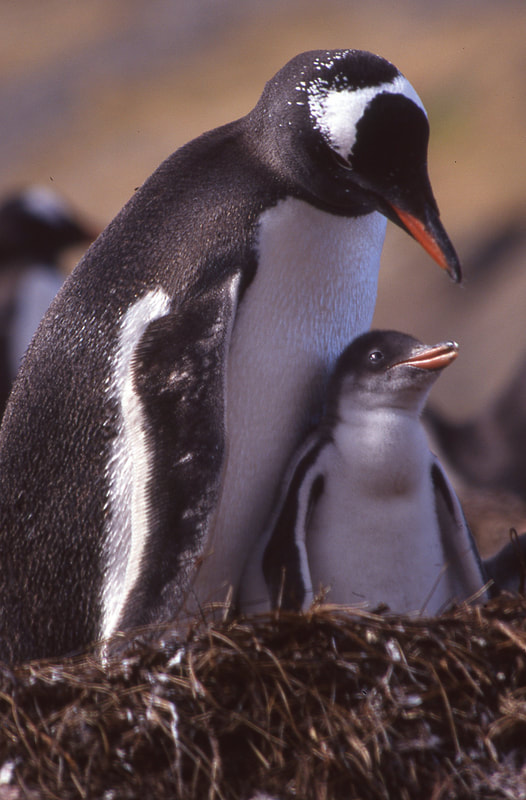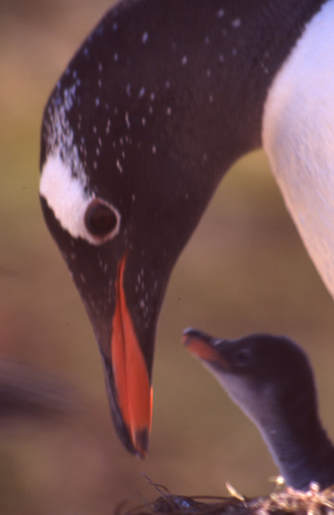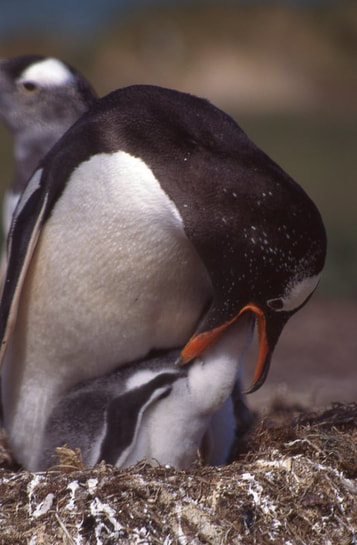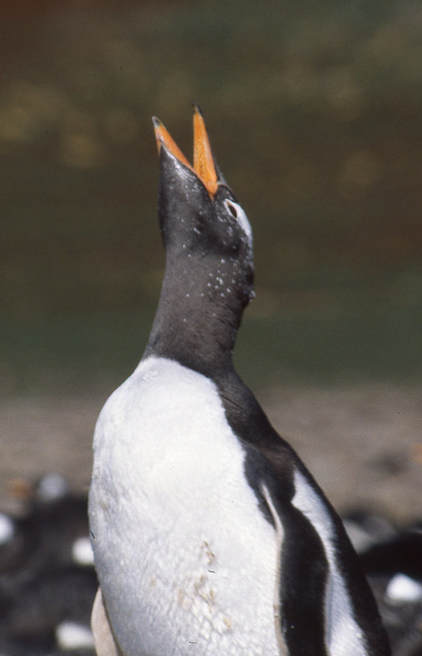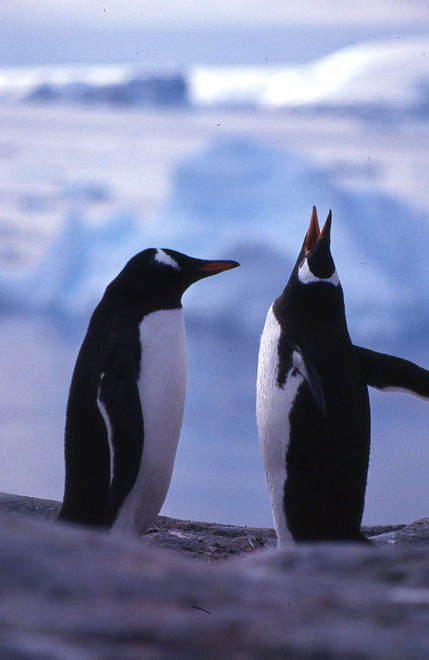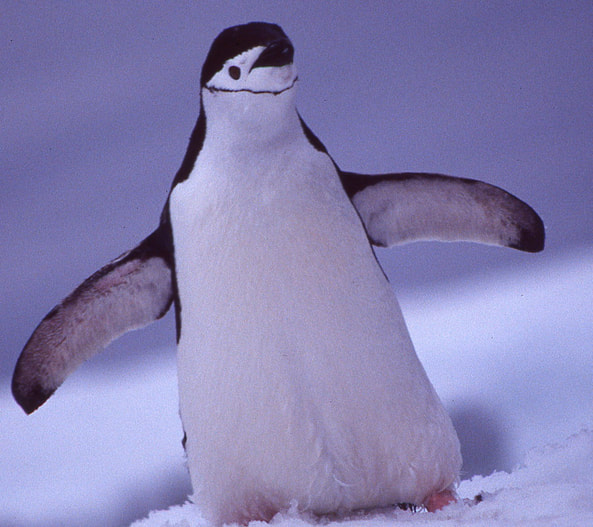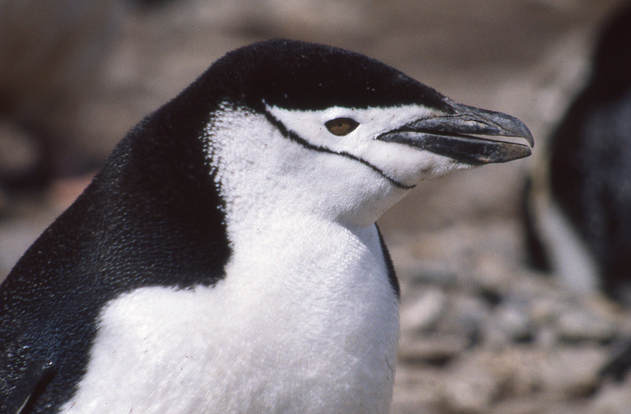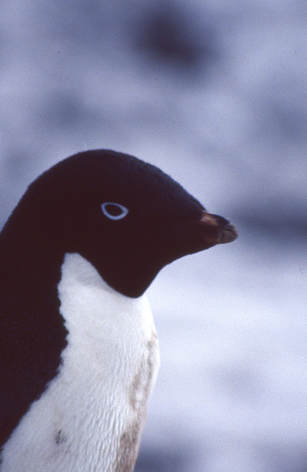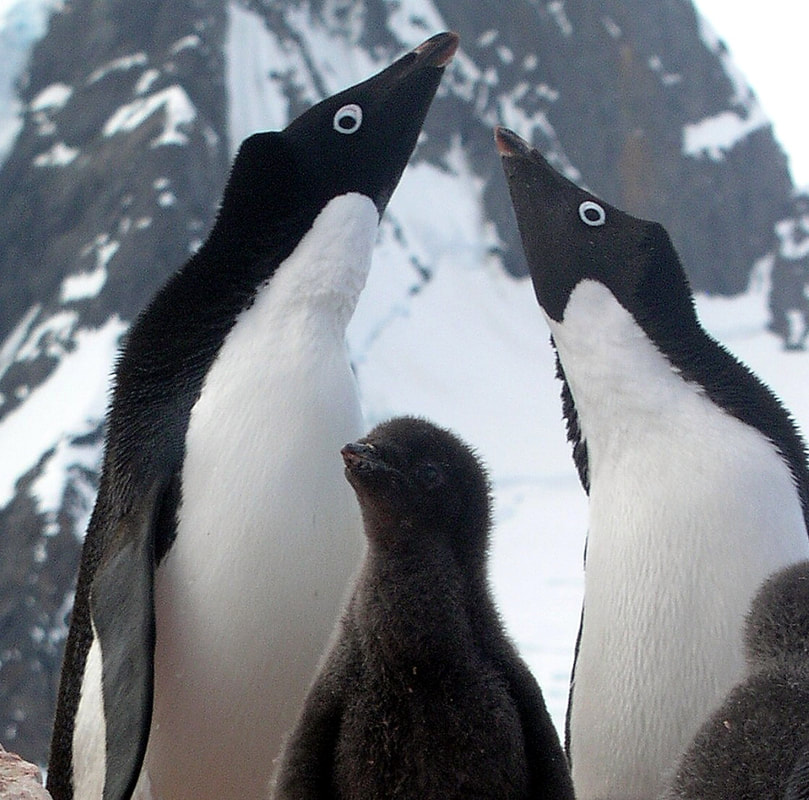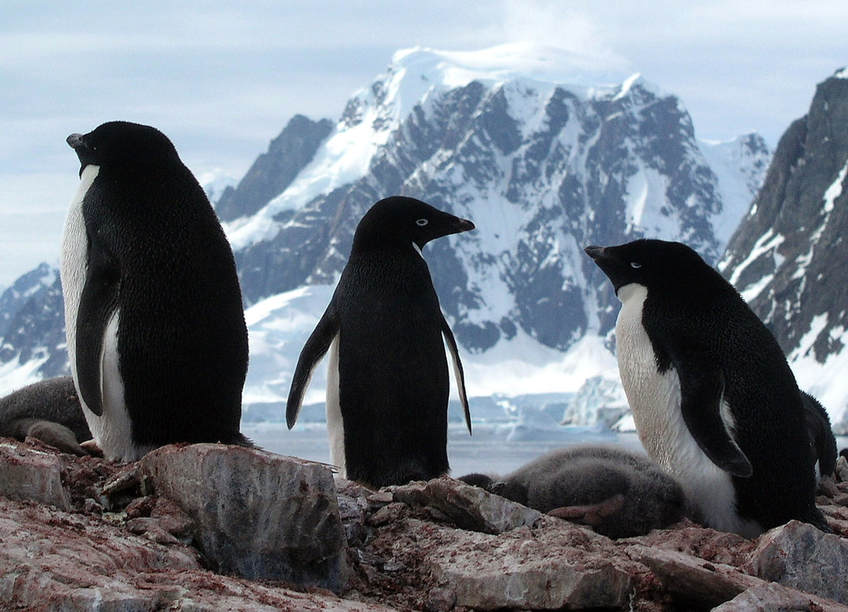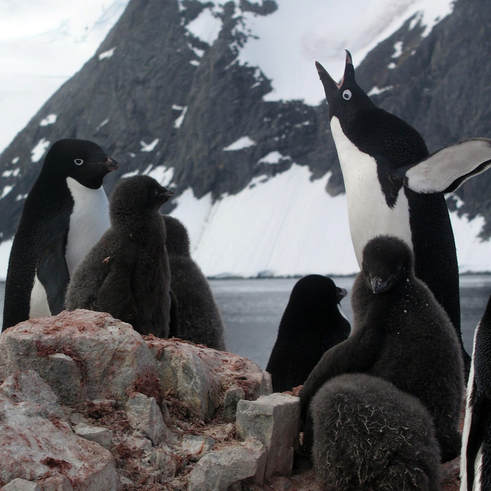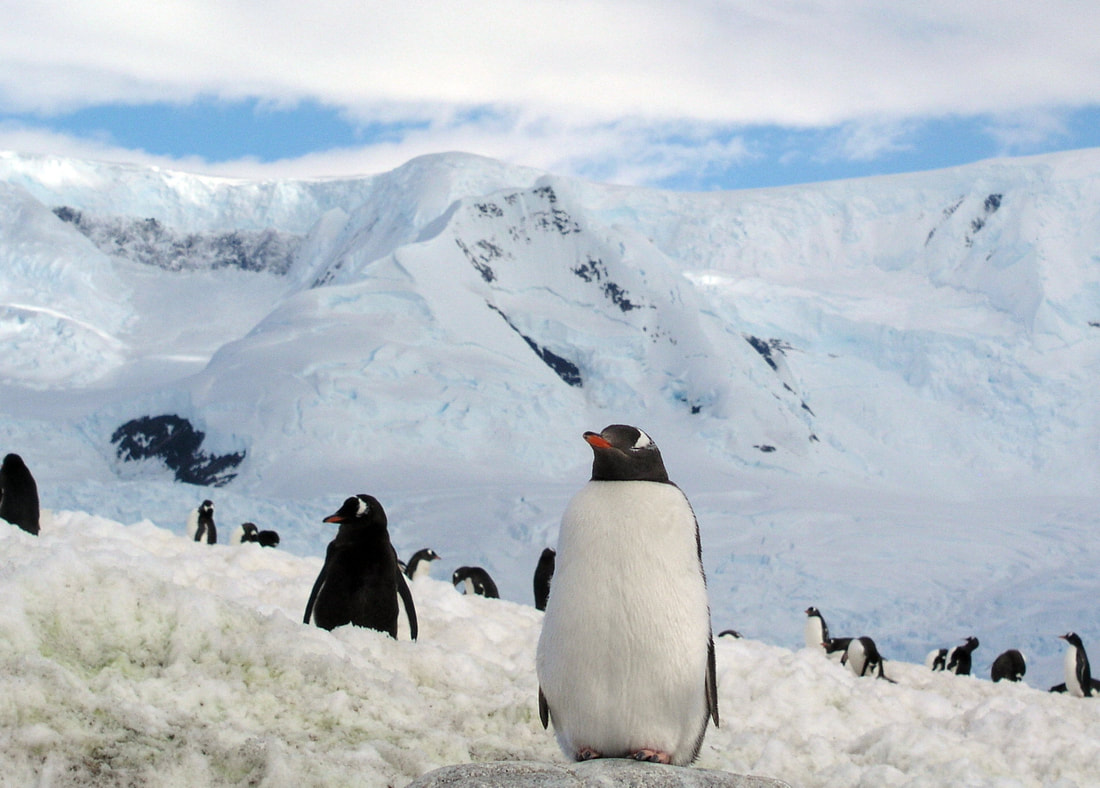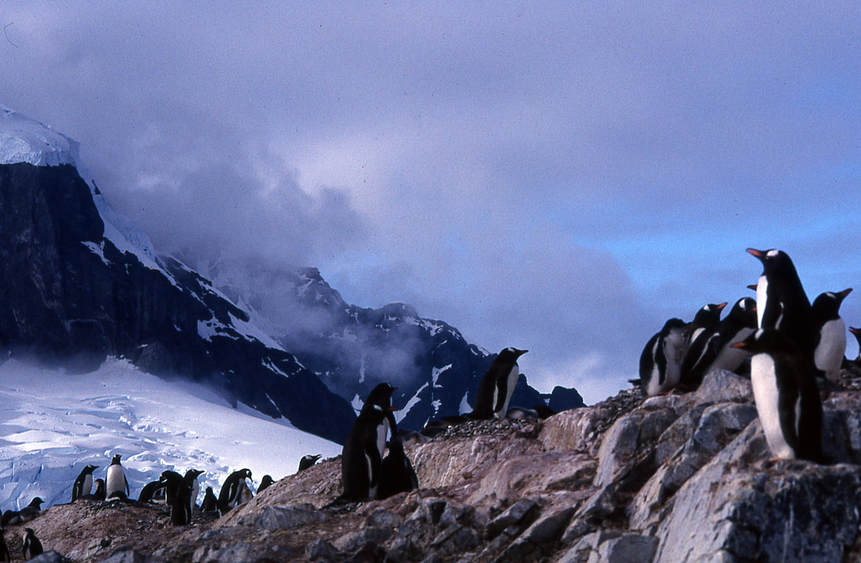Everyone loves penguins; they’re endearing, beautiful, and sometimes appear comical to us. The Adélie penguins pictured above radiate a warmth, even in their cold habitat. The origins of their name are various; there’s the Welsh pen gyn (“white head”), the Latin pinguis (fat), and the term used by the Brit sailors “pin wings”. They were once thought of as part bird and part fish; a Catholic could eat them on Friday. Aside from a few colonies of Galápagos penguins just north of the equator, they are found only in the Southern Hemisphere. They are black and white, a form of camouflage used by many seafaring animals (whales, sea birds, fish) called “countershading”; from below you see white on white, and from above you see black on black.
Penguins are often called flightless birds, but truth be told, they actually can fly – in the water. Most flightless birds have atrophied wings; not so the penguins. Their wings are modified for propulsion (flight) underwater and they have a strong attachment to the keel (the raised part of the sternum). The elbow and wrist joints are fused and quite rigid; the shoulder movement is also limited. It is not capable of folding its wings, and the appearance of these straightened flippers give them a humanesque image. The power comes from the upstroke, and the air pressure differential between the upper and lower surface of their wings gives them flight (per Bernouilli’s Law). The backbones are also fused to anchor the muscles that move the wings; the pointy tail also acts a rudder. The end result is a maintained speed of 10-15 mph, and spurts double that.
With that strong of a wing, why can’t they fly through the air as well? First, these are diving birds, with the depth they reach varying by species; many penguin species reach 500 ft. and the Emperor Penguin can dive as deep as 1800 ft. As in the case of the cormorants, penguins need solid bones in order to facilitate dive deeping, especially with their thick layer of fat (or blubber) - to guard against the extreme cold. They float low on the surface, and with their weight, they can not take off. There are penguin-like birds that do fly in the air as well as the water; you can read about the Alcids (auklets, murres, puffins, etc.) in the Section on the Norwegian Arctic. Many of these Alcids weigh less than a pound, and almost all the others between 1-2 pounds. The smallest penguin (the Little, Blue or Fairy Penguin) weigh over 3 pounds.
There are many factors involved in the penguins diving ability, including their ability to significantly slow their heart rates. As with the marine mammals (seals/ sea lions and whales), penguins also use the protein myoglobin to transport oxygen to the muscles, where it is stored; this replaces the normal hemoglobin transfer of oxygen to the body tissues.
Penguins are often called flightless birds, but truth be told, they actually can fly – in the water. Most flightless birds have atrophied wings; not so the penguins. Their wings are modified for propulsion (flight) underwater and they have a strong attachment to the keel (the raised part of the sternum). The elbow and wrist joints are fused and quite rigid; the shoulder movement is also limited. It is not capable of folding its wings, and the appearance of these straightened flippers give them a humanesque image. The power comes from the upstroke, and the air pressure differential between the upper and lower surface of their wings gives them flight (per Bernouilli’s Law). The backbones are also fused to anchor the muscles that move the wings; the pointy tail also acts a rudder. The end result is a maintained speed of 10-15 mph, and spurts double that.
With that strong of a wing, why can’t they fly through the air as well? First, these are diving birds, with the depth they reach varying by species; many penguin species reach 500 ft. and the Emperor Penguin can dive as deep as 1800 ft. As in the case of the cormorants, penguins need solid bones in order to facilitate dive deeping, especially with their thick layer of fat (or blubber) - to guard against the extreme cold. They float low on the surface, and with their weight, they can not take off. There are penguin-like birds that do fly in the air as well as the water; you can read about the Alcids (auklets, murres, puffins, etc.) in the Section on the Norwegian Arctic. Many of these Alcids weigh less than a pound, and almost all the others between 1-2 pounds. The smallest penguin (the Little, Blue or Fairy Penguin) weigh over 3 pounds.
There are many factors involved in the penguins diving ability, including their ability to significantly slow their heart rates. As with the marine mammals (seals/ sea lions and whales), penguins also use the protein myoglobin to transport oxygen to the muscles, where it is stored; this replaces the normal hemoglobin transfer of oxygen to the body tissues.
The wings/ flippers are also useful in thermoregulation Sometimes you will see a penguin on shore with its wings held out at an angle. It turns out there is a network in the blood vessels of the wing whereby the arteries and veins are intertwined. This is essentially a heat exchange system where the cooler venous blood is heated by the warmer arterial blood. As penguins are so well insulated, the system can also work the other way whereby the venous blood cools the warmer arterial blood. The system is given the name “arteriovenous anastomoses” or “rete mirabile” (wonderful net – Latin). Sea lions have the same sort of
system, and you’ll often notice a sea lion flipper extending up from the water. Although not discussed in the literature, thermoregulation may have come first (before flight) in some birds; just my own little speculation. Their insulation doesn’t come from just the blubber; they have over 100 feathers per square inch, the densest concentration of any bird, covering the entire body. In addition, the bird's muscles hold the feathers erect on land, thereby trapping a layer of air over the skin. In water, the plumage is flattened,
thus waterproofing the skin and downy layer. The insulation is so efficient on land that
if a snowflake landed on a penguin’s skin, it would not melt.
system, and you’ll often notice a sea lion flipper extending up from the water. Although not discussed in the literature, thermoregulation may have come first (before flight) in some birds; just my own little speculation. Their insulation doesn’t come from just the blubber; they have over 100 feathers per square inch, the densest concentration of any bird, covering the entire body. In addition, the bird's muscles hold the feathers erect on land, thereby trapping a layer of air over the skin. In water, the plumage is flattened,
thus waterproofing the skin and downy layer. The insulation is so efficient on land that
if a snowflake landed on a penguin’s skin, it would not melt.
The colorful feather plumes on the crest is what is known as the "sexual characteristic" of the species. It's what they develop as an adult (juveniles do not have these markings). Same as the foot color on the Blue-Footed and Red- Footed Boobies. All penguin species have their sexual characteristics on their heads (unique head markings); there's the auricular ear patches of the Emperor and King, the crested plumes of the Macaroni (above) and Rockhopper, the facial outline of the Chinstrap, the ear bonnet of the Gentoo, and the horseshoe marking of the Galápagos. This may seem odd at first, until you realize that penguins spend most of the year in the water and they are "low riders" (as they have sold bones - for diving). So, as they eye each other from the water (part of their courtship), what they see most of - is each other's heads.
THE EMPEROR PENGUIN
The Emperor Penguin is a very special bird, and the one everyone wants to see. More on that in a bit. It is the tallest (45-48”) and heaviest (50-100 lb.) of all living penguin species and is endemic to Antarctica; there are fossils of penguins that weighed several hundred pounds, and they've actually gotten smaller and faster over time. The male and female are similar in plumage. Their sexual characteristic is a pale yellow auricular (ear) marking, similar (although more subtle) to the ear patch on their cousin, the King Penguin (see below). Their menu is largely fish, with squid and other invertebrates as well. The Emperor is the deepest diving of the 18 penguin species, and can stay at depth for 20 minutes or so.
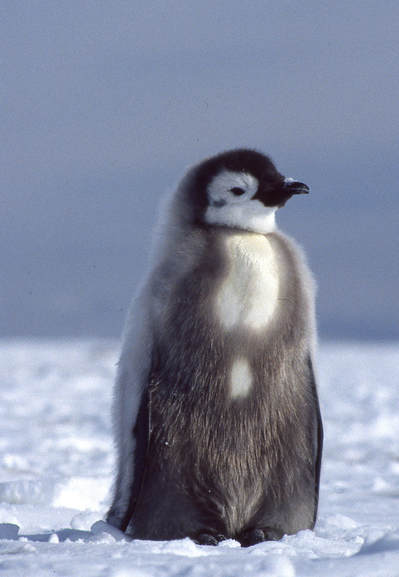
What is most notable about the Emperor Penguin is that it is the only penguin that breeds during the Antarctic winter. Many of us have seen videos (March of the Penguins, etc.) that document this amazing activity. First, they trek 25-75 miles over the ice to their breeding colony which may include several hundred individuals. These colonies are well chosen, based on proximity to the water and wind protection formed by surrounding features, such as large ice bergs, cliffs, etc. The female lays a single egg, which is then carefully transferred to, and incubated by, the male, and she returns to the sea to feed - gone for some 2 months. The males keep the egg warm by balancing the egg on their feet and covering them with the feather-covered brood pouch (it is bare in most birds). You can see the brood patch in the section below (on King Penguins). When the chick hatches, it remains within the brood patch except for a breather now and then; outside of this area, it would die in short time. The male does not feed during this time; in fact, has not eaten for almost 4 months and is largely at the mercy of the elements. In all, he will lose nearly half his weight. He can amazingly produce a glandular milk (protein and fat) that it is able to feed the chick. The males in the colony do huddle together to conserve warmth and to escape the winds. Individuals gradually reach the inner, more protected areas; from there, they return to the periphery and give other males a chance for warmth and protection. When the female returns, the chick is fed a good supply of food. The male then makes his own journey to the sea, and the female then stays with the chick, continuing to feed it and keep it warm. By the time the chick is nearly 2 months old, it requires sufficient food that it takes both parents feeding at sea at the same time. During their absence, which will be longer and longer, the chicks in the colony huddle together in a large group, called a crèche. Another winter will come and go. If all goes well, it will soon molt into it's first year plumage (waterproofing included), and be able to go sea to feed on its own when the pack ice breaks up once again (around December; both parents will be gone by then.
A final note here; more of a heads-up. Many people that voyage to the Antarctic think there going to see Emperor Penguins, and they are disappointed when they don't. We've already pointed out in the introduction to this section that few ships go further south than 66 Deg (near the edge of the Antarctic Circle); that's where the series ice begins, and most ships are not rated for heavy-duty ice. Even the sometimes-seen Emperor colony on Snow Hill Island in the Weddell Sea requires a serious ice-rated vessel to get close. The trip that I saw them, I was on a nuclear icebreaker; the cost of these special expeditions are 4 times what a normal voyage would run. And even if you did go on such a voyage, the Emperor colonies are gone as soon as the pack ice begins to break up; we were lucky to see a small colony in January. The helicopter spotted the colony for us, a "not for free" service.
But don't be sad. Plan a trip that goes to the sub-Antarctic island of South Georgia; it's just a few days longer, and there you will get to see literally hundreds of thousands of King Penguins, a marvelous experience you will not forget! They're up next.
A final note here; more of a heads-up. Many people that voyage to the Antarctic think there going to see Emperor Penguins, and they are disappointed when they don't. We've already pointed out in the introduction to this section that few ships go further south than 66 Deg (near the edge of the Antarctic Circle); that's where the series ice begins, and most ships are not rated for heavy-duty ice. Even the sometimes-seen Emperor colony on Snow Hill Island in the Weddell Sea requires a serious ice-rated vessel to get close. The trip that I saw them, I was on a nuclear icebreaker; the cost of these special expeditions are 4 times what a normal voyage would run. And even if you did go on such a voyage, the Emperor colonies are gone as soon as the pack ice begins to break up; we were lucky to see a small colony in January. The helicopter spotted the colony for us, a "not for free" service.
But don't be sad. Plan a trip that goes to the sub-Antarctic island of South Georgia; it's just a few days longer, and there you will get to see literally hundreds of thousands of King Penguins, a marvelous experience you will not forget! They're up next.
KING PENGUINS
As mentioned, King Penguins are the first cousins of the Emperors; they are of the same Genus. And they have the same look to them– large, colorful, both with ear patches, etc. The King Peguins are smaller, averaging just over 30 lbs. in weight and a bit over 3 ft. in height. But they have more color to their markings, the orange on their throats, lower bill, and auricular (ear) patches. They’re really quite beautiful to look at. There are 2 subspecies, one in the Atlantic (found in the Falklands and a huge population in South Georgia), and the other in the Indian Ocean and South Pacific. The Kings do not dive as deep as the Emperors, but they stay at their maximum depth of several hundred feet for quite a while.
Their favorite food (the lanternfish) is one that bioluminesces (lights up), with some species having the”light” growing from their foreheads, acting as a lure. The biomass of lanternfish is still quite significant.
Their favorite food (the lanternfish) is one that bioluminesces (lights up), with some species having the”light” growing from their foreheads, acting as a lure. The biomass of lanternfish is still quite significant.
As noted, the King Penguin has an unusual breeding cycle, taking 14–16 months from laying the egg to the fledging of the offspring. If you’re an early breeder in year one, you’ll be a late breeder in the following year, and probably won’t be successful, due to the timing. One out of every two years is typical, but two out of three successful years is also possible. This is the reason you see so many stages of development
within the same colony.
There's another factor. The fidelity of an adult is to the carefully-chosen nest site of the previous year (sheltered, proximity to the shore, etc.) and an on-time arrival, as time is critical to successful breeding. With penguins, the male and female breeding pair from last year arrive separately. Upon arrival, Step 2 is waiting for your mate from last year to arrive; at some point, you have to stop waiting (time considerations again) and take up with a new partner. Studies have shown a significantly greater fidelity in penguins to nest site than to last year’s mate, which makes sense. By the way, Murphy’s Law applies to penguins as well; just when you have given up on the arrival of last year’s mate and have chosen a new one, who casually shows up? You guessed it, and then the fights are on. Although, being penguins, they sometimes do a “displacement fight” by flapping their wings at each other while looking the other way and walking along together at the same time. It makes for hilarious video, but it’s serious stuff to them. Typically, if it’s not way late, the mate from last year will be selected regardless of the outcome of said fight. And for the record, both males and females have the same tendency to be first ashore or be one of the fighters.
Once again, the first pairs to arrive get the best nest sites, and as such, are the most successful at
raising the chick(s). This factoid is not lost on predators, such as the Antarctic Skua or Southern
Giant Petrel). They know that the least desirable nest sites are occupied by less experienced parents
and the odds of nabbing a chick or egg are higher. Location, location.
Life in the hood. That’s the way it works.
within the same colony.
There's another factor. The fidelity of an adult is to the carefully-chosen nest site of the previous year (sheltered, proximity to the shore, etc.) and an on-time arrival, as time is critical to successful breeding. With penguins, the male and female breeding pair from last year arrive separately. Upon arrival, Step 2 is waiting for your mate from last year to arrive; at some point, you have to stop waiting (time considerations again) and take up with a new partner. Studies have shown a significantly greater fidelity in penguins to nest site than to last year’s mate, which makes sense. By the way, Murphy’s Law applies to penguins as well; just when you have given up on the arrival of last year’s mate and have chosen a new one, who casually shows up? You guessed it, and then the fights are on. Although, being penguins, they sometimes do a “displacement fight” by flapping their wings at each other while looking the other way and walking along together at the same time. It makes for hilarious video, but it’s serious stuff to them. Typically, if it’s not way late, the mate from last year will be selected regardless of the outcome of said fight. And for the record, both males and females have the same tendency to be first ashore or be one of the fighters.
Once again, the first pairs to arrive get the best nest sites, and as such, are the most successful at
raising the chick(s). This factoid is not lost on predators, such as the Antarctic Skua or Southern
Giant Petrel). They know that the least desirable nest sites are occupied by less experienced parents
and the odds of nabbing a chick or egg are higher. Location, location.
Life in the hood. That’s the way it works.
The population of King Penguins is over 2 million breeding pairs, and South Georgia is the place to see them. There are several Visitor Sites with large populations, such as Gold Harbor, Hercules Bay, and the Salisbury Plain, but the site that astounds everyone with the vast numbers is St. Andrews Bay (shown here) where several hundred thousand King Penguins are everyewhere, from the beach all the way back to the mountains. Due to their unusual breeding cycle (to be described), every stage of development is seen in large numbers – courting couples, adult with egg, adult with chick, colonies of adults, colonies of juveniles (crèches) in their brown “raccoon coats” . Usually, when you visit a bird rookery or colony, all the individuals are at the same stage of development or doing the same behavior; not the case here.
This is the brood patch described in detail in the section on Emperor Penguins. While all birds have a brood patch, it is a bare area of skin that covers the egg when the parent is sitting in the nest. Not so in the Emperors and Kings. In the photo (above right), you can see the feathery fold of abdominal skin rolling down over the egg; it's always a great image when it rolls back up, revealing the egg or chick while
letting it get some air.
letting it get some air.
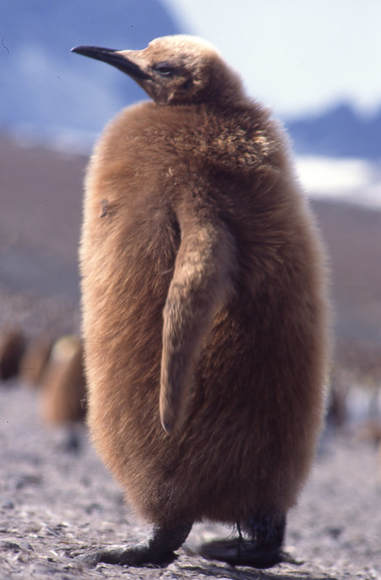
King Penguin chicks are covered in a downy brown feathers. It reminds me of the raccoon coats worn to football games in the 1920s, with a flask in the pocket. The sealers called them "oakum boys" as their coats looked like the oakum material (a tarred fibre) used to wedge between the seams of a boat to make it watertight.
To feed a young chick, the parents alternate feeding runs of several days; this is called the "guard stage" which lasts for over a month. By then the chick has grown, can keep itself warm, and protect itself when necessary. At that point, both parents can go to sea and feed at the same time. The chicks learn to group up in "crèches" for warmth and protection. Parental visits become fewer and further between over the winter, and the chicks have to tighten the crèche," actually forming a tight huddle, to survive the frigid conditions. They lose up to half their body weight, as the parents can only return every 4-6 weeks at best to feed them; the wait can actually be a few months on occasion. Life in the Freezer is always a race for chicks to develop sufficiently to get out before the freezer door slams shut. They don't all make it, but typically enough to keep the population at least constant.
MACARONI PENGUINS
There are several species of crested penguins in the sub-Antarctic islands (5-7, depending on the taxonomic source), all with reddish bills and yellow crests as their sexual characteristic (see definition at the top part of this section). They also share another interesting characteristic; they lay 2 eggs but only 1 survives. With other birds, the first egg is laid (and hatches) a few days ahead of the second, and therefore the first chick (being larger) outcompetes the younger one for food being offered by the parent(s). The second egg is called an insurance egg, in case the first doesn't make it. In the case of crested penguins, however, the first egg is small, addled, and hardly ever hatches. As the expression goes, "what's up with that?" The theory is that we're actually seeing evolution on the go, and the birds are going from a 2-egg layer to a 1-egg layer. Keep checking back here every decade or so, and I may have an update.
There are several species of crested penguins in the sub-Antarctic islands (5-7, depending on the taxonomic source), all with reddish bills and yellow crests as their sexual characteristic (see definition at the top part of this section). They also share another interesting characteristic; they lay 2 eggs but only 1 survives. With other birds, the first egg is laid (and hatches) a few days ahead of the second, and therefore the first chick (being larger) outcompetes the younger one for food being offered by the parent(s). The second egg is called an insurance egg, in case the first doesn't make it. In the case of crested penguins, however, the first egg is small, addled, and hardly ever hatches. As the expression goes, "what's up with that?" The theory is that we're actually seeing evolution on the go, and the birds are going from a 2-egg layer to a 1-egg layer. Keep checking back here every decade or so, and I may have an update.
The Macaroni is the largest of the crested penguins, with a height of 28 inches and adults weighing about 14 pounds. You can see how the crests start between the eyes and then extend over each and then
back to the side of the head. This is very different than the modest crests seen on the
Rockhopper Penguin seen in the next section.
back to the side of the head. This is very different than the modest crests seen on the
Rockhopper Penguin seen in the next section.
With over 6 million breeding pairs, the Macaroni Penguin has the largest population of any penguin. But all is not well, as it is listed as "Vulnerable" as these numbers have gone down by about a third over the last 20 years. The exact case is not known, but it is most probably linked to a major drop in the krill population, which is by far its preferred food. This certainly ties into global warming and the loss of sea ice in Antarctica, which is a habitat of the krill - both for protection and for food (the algae growing in the ice).
There are not many animals named after clothing fashion, but apparently the Macaronis were. Seems that in the 18th Century, fashionable men would travel yp Italy and learned to put feathers in their hats, thereby joining the "Macaroni Club." If you were called a "Macaroni," it was anything but a term of endearment. The same applied to the American "soldiers" during the Revolutionary War; as they really couldn't afford uniforms, the enlisted men did the best they could to look professional - yes, they became "Yankee Doodle Dandies," and you know the rest of the song. And since these penguins were named by English explorers, you can see the name origin very clearly.
There are not many animals named after clothing fashion, but apparently the Macaronis were. Seems that in the 18th Century, fashionable men would travel yp Italy and learned to put feathers in their hats, thereby joining the "Macaroni Club." If you were called a "Macaroni," it was anything but a term of endearment. The same applied to the American "soldiers" during the Revolutionary War; as they really couldn't afford uniforms, the enlisted men did the best they could to look professional - yes, they became "Yankee Doodle Dandies," and you know the rest of the song. And since these penguins were named by English explorers, you can see the name origin very clearly.
Macaroni Penguin courtship involves the usual displays, including allopreening (above). And there's also an "ecstatic" display, with bowing forward, straightening up and shaking the head back & forth while bellowing loudly. But it goes way beyond that. The breeding colonies are madhouses of activity (see below). There's a lot of jousting and serious confrontational behavior, with locked bills and flipper strikes. The works. It is an extremely loud place, not the least bit inviting. But it's their way, and when it's all said and done, nests are scraped out of mud (or tussock grass in some locations); a few stones are added for reinforcement.
ROCKHOPPER PENGUINS
Rockhoppers are the smallest of the crested penguins, little butterballs weighing about 5 pounds and slightly under 2 feet in height. Their crests are yellowish - spiky projections on either side of the head. They also have black spiky feathers in the central portion of their heads. True to their name, they do have the ability to hop (as well as jump several feet at a time) from rock to rock, even up steep slopes, as they exit the water and make for their nesting area way up there. Despite their small size, I have the utmost of respect for them; In the Falklands, I have seen them thrown by large powerful waves against cliffsides,
only to bounce off and try to make landfall once again, leaping up out of the water
to a ledge. It's quite an amazing spectacle; without their body fat,
no way could they absorb such punishment.
Rockhoppers are the smallest of the crested penguins, little butterballs weighing about 5 pounds and slightly under 2 feet in height. Their crests are yellowish - spiky projections on either side of the head. They also have black spiky feathers in the central portion of their heads. True to their name, they do have the ability to hop (as well as jump several feet at a time) from rock to rock, even up steep slopes, as they exit the water and make for their nesting area way up there. Despite their small size, I have the utmost of respect for them; In the Falklands, I have seen them thrown by large powerful waves against cliffsides,
only to bounce off and try to make landfall once again, leaping up out of the water
to a ledge. It's quite an amazing spectacle; without their body fat,
no way could they absorb such punishment.
Notice the red eyes of the Rockhopper Penguins (below) As the Macaronis, the Rockhoppers are krill eaters, and their once large population has fallen quite a bit, down to about 3 million or so;
they are now classified as Vulnerable. The same reasons are given for
both population declines (see above).
they are now classified as Vulnerable. The same reasons are given for
both population declines (see above).
GENTOO PENGUINS
THE CHINSTRAP PENGUIN
When the terrain is covered by snow and ice, several penguin species alternate between a wobbling walk and tobogganing—sliding and gliding over the ice on its belly, using the feet and flippers for propulsion.
The wings/ flippers are also useful in thermoregulation. See how the Chinstrap is holding its wings held out at an angle. It turns out there is a network in the blood vessels of the wing whereby the arteries and veins are intertwined. This is essentially a heat exchange system where the cooler venous blood is heated by the warmer arterial blood. As penguins are so well insulated, the system can also work the other way whereby the venous blood cools the warmer arterial blood. The system is given the name “arteriovenous anastomoses” or “rete mirabile” (wonderful net – Latin). Sea lions have the same sort of system, and
you’ll often notice a sea lion flipper extending up from the water. Although not discussed in the literature, thermoregulation may have come first (before flight) in some birds; just my own little speculation. Their insulation doesn’t come from just the blubber; they have over 100 feathers per square inch, the densest concentration of any bird, covering the entire body. In addition, the bird's muscles hold the feathers erect on land, thereby trapping a layer of air over the skin. In water, the plumage is flattened, thus
waterproofing the skin and downy layer. The insulation is so efficient on land that
if a snowflake landed on a penguin’s skin, it would not melt.
The wings/ flippers are also useful in thermoregulation. See how the Chinstrap is holding its wings held out at an angle. It turns out there is a network in the blood vessels of the wing whereby the arteries and veins are intertwined. This is essentially a heat exchange system where the cooler venous blood is heated by the warmer arterial blood. As penguins are so well insulated, the system can also work the other way whereby the venous blood cools the warmer arterial blood. The system is given the name “arteriovenous anastomoses” or “rete mirabile” (wonderful net – Latin). Sea lions have the same sort of system, and
you’ll often notice a sea lion flipper extending up from the water. Although not discussed in the literature, thermoregulation may have come first (before flight) in some birds; just my own little speculation. Their insulation doesn’t come from just the blubber; they have over 100 feathers per square inch, the densest concentration of any bird, covering the entire body. In addition, the bird's muscles hold the feathers erect on land, thereby trapping a layer of air over the skin. In water, the plumage is flattened, thus
waterproofing the skin and downy layer. The insulation is so efficient on land that
if a snowflake landed on a penguin’s skin, it would not melt.
ADÉLIE PENGUINS

The Adélie, Chinstrap, and Gentoo Penguins belong to a common genus, Pygoscelis. This translates to "rump-legged", but they are called by a more civil name, "brush-tailed penguins." And indeed they have brush-like or wedge-shaped tail. Among its usual functions, it is used a 3rd leg for balance while ambling over the rocks, somewhat like a tripod. All the Pygoscelids raise 2 chicks.
The courtship rituals of seabirds is both simple and complex. The behavior at any given time can be given a label. For example, the Adélie Penguins in the photo above (right) appear to be making a courtship call to each other. But they already appear to have chicks, so what's going on? The complexity here is properly interpreting the behavior. Quite often, what we see is not what we would call foreplay; "after-play" would be a better term. That is to say that they've already mated and had chicks, etc., but they need to keep reinforcing the pair-bond at certain times - coming back to the nest with food, "changing of the guard" (exchanging the responsibility and care of the chick[s] and/ or egg[s], etc. Sort of a peck on the cheek or saying "I love you" - earning the right to get parental responsibility.
|
For catching their prey, the beaks have
cutting edges as sharp as razors There are many backward-pointing barbs on the tingue and the back of the mouth, keeping the catch moving in the right direction. Also, If a penguin has been eating fish, the excreta is white, krill is pink (left), and fasting during a molt - green (bile - above). |
